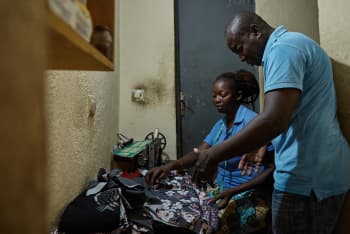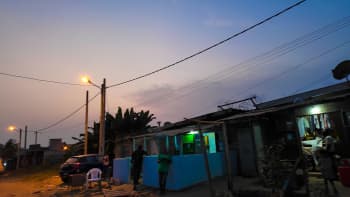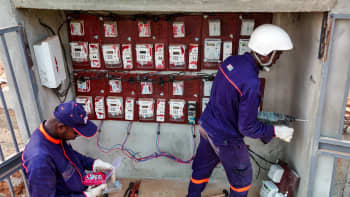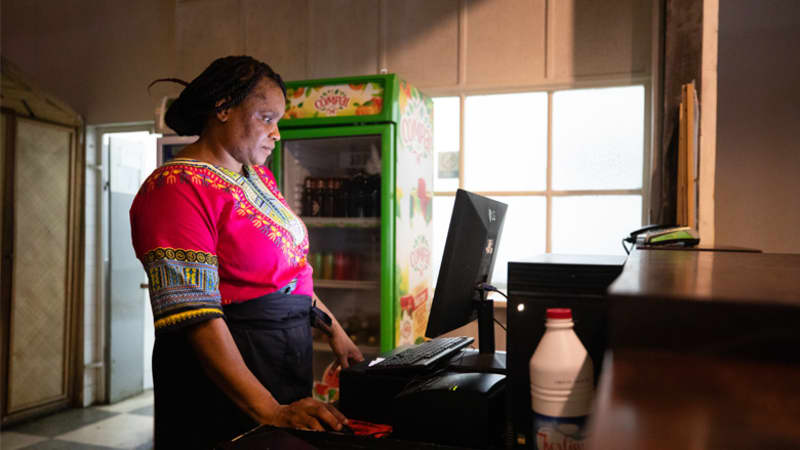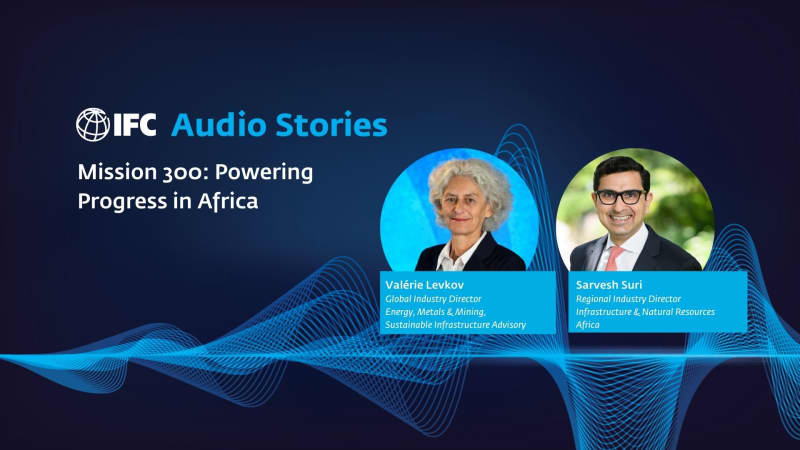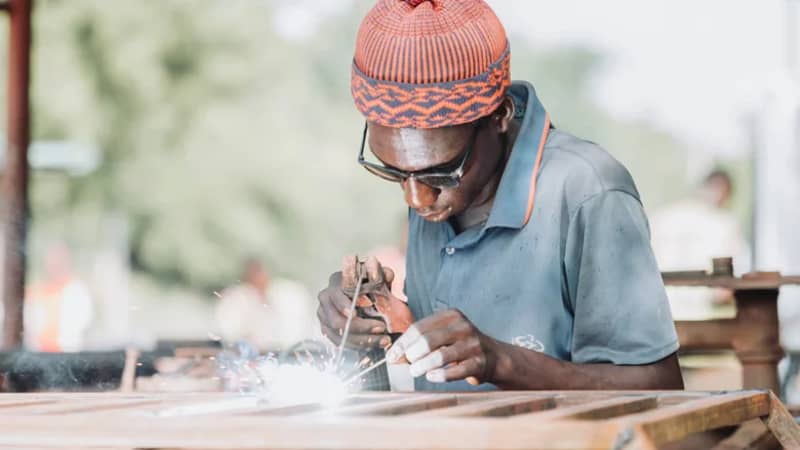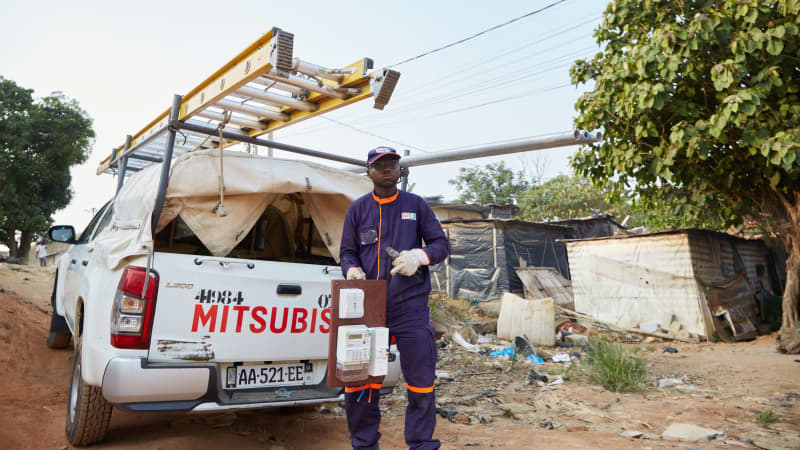Côte d’Ivoire Nears Universal Access to Electricity
Flexible financing helps low-income households and communities afford electrical meters, boosting small businesses and families’ quality of life.
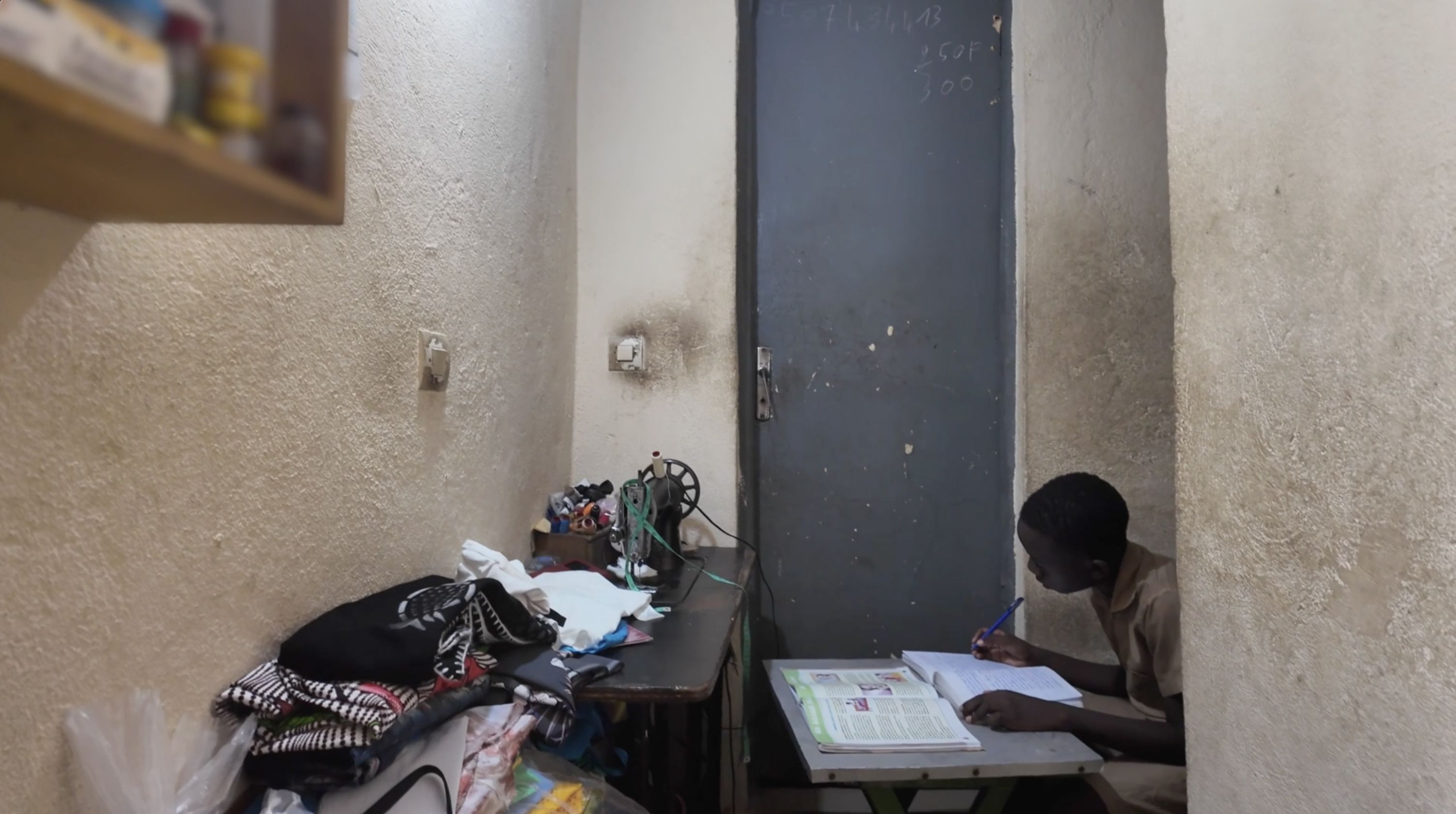
Shortly after 10-year-old Aziz Kima finishes his math homework, he closes the book and turns to his mother with a smile. Although it’s evening, the room is brightly lit—in contrast to the days before the family’s electrical meter was installed. “Thanks to the electricity, he can review his lessons and do his exercises in the evening,” says his mother, Gisèle Kima, a seamstress. “It is more practical and less dangerous than studying by candlelight.” Her work has benefitted from the family’s hookup to the national grid, too: she can fulfill more orders and is less tired, she says, than when she had to pedal to power a manual sewing machine.
The Kima family's connection will contribute to the more than 13 percent increase in the nationwide electricity access rate over the next four years.
The Kima family's connection will contribute to the more than 13 percent increase in the nationwide electricity access rate over the next four years.
The Kima family lives in Anono, a low-income village on the outskirts of Abidjan, Côte d’Ivoire. Although government figures indicate that Côte d’Ivoire had 88 percent electricity coverage in 2023—and the government estimates that nearly 94 percent of the country had coverage in 2024— about 36 percent of Ivoirians can’t afford to install the meter that allows them to access power. The Kimas used to be among them. At an average of XOF 150,000, or about $250, cost was a barrier.
But support from the World Bank Group, including the International Development Association (IDA) and an investment from IFC, is helping a successful government initiative reach some of the country’s last people without power. IFC’s anchor investment of $48.8 million in a $97.6 million social bond raised money to fund the cost of installing the meters—part of a groundbreaking program that offers access to electricity to the poorest, most vulnerable citizens.
Côte d’Ivoire’s program, Electricity for All (known in French as Programme Electricité Pour Tous, or PEPT), offers flexible financing so people can afford the cost of installing the meters. It enabled the Kima family to pay just XOF 1,000 (about $1.50) for the connection and to continue on a pay-as-you-go plan. The program has facilitated access to power for over 2 million low-income Ivoirian households—double the number of connections since its launch in 2014.
The Kimas paid about $1.50 for an electrical meter to be installed outside their home.
The Kimas paid about $1.50 for an electrical meter to be installed outside their home.
IFC’s investment is part of a three-decade World Bank Group effort to expand Côte d’Ivoire’s power supply and improve people’s quality of life. Together, the IDA and IFC efforts will help the government reach its goal of establishing over 800,000 additional connections over the next four years, a more than 13 percent increase in the nationwide electricity access rate.
Côte d’Ivoire’s Electricity for All initiative advances the goals of Mission 300, a World Bank Group-African Development Bank Group partnership to provide at least 300 million people in Africa with clean and reliable electricity access by 2030. “Electricity powers education, healthcare, innovation, and jobs, and is key to Africa's development,” says Makhtar Diop, Managing Director, IFC. “As private sector investment reshapes the continent’s energy landscape, it opens new opportunities, bringing millions closer to the promise of reliable electricity.”
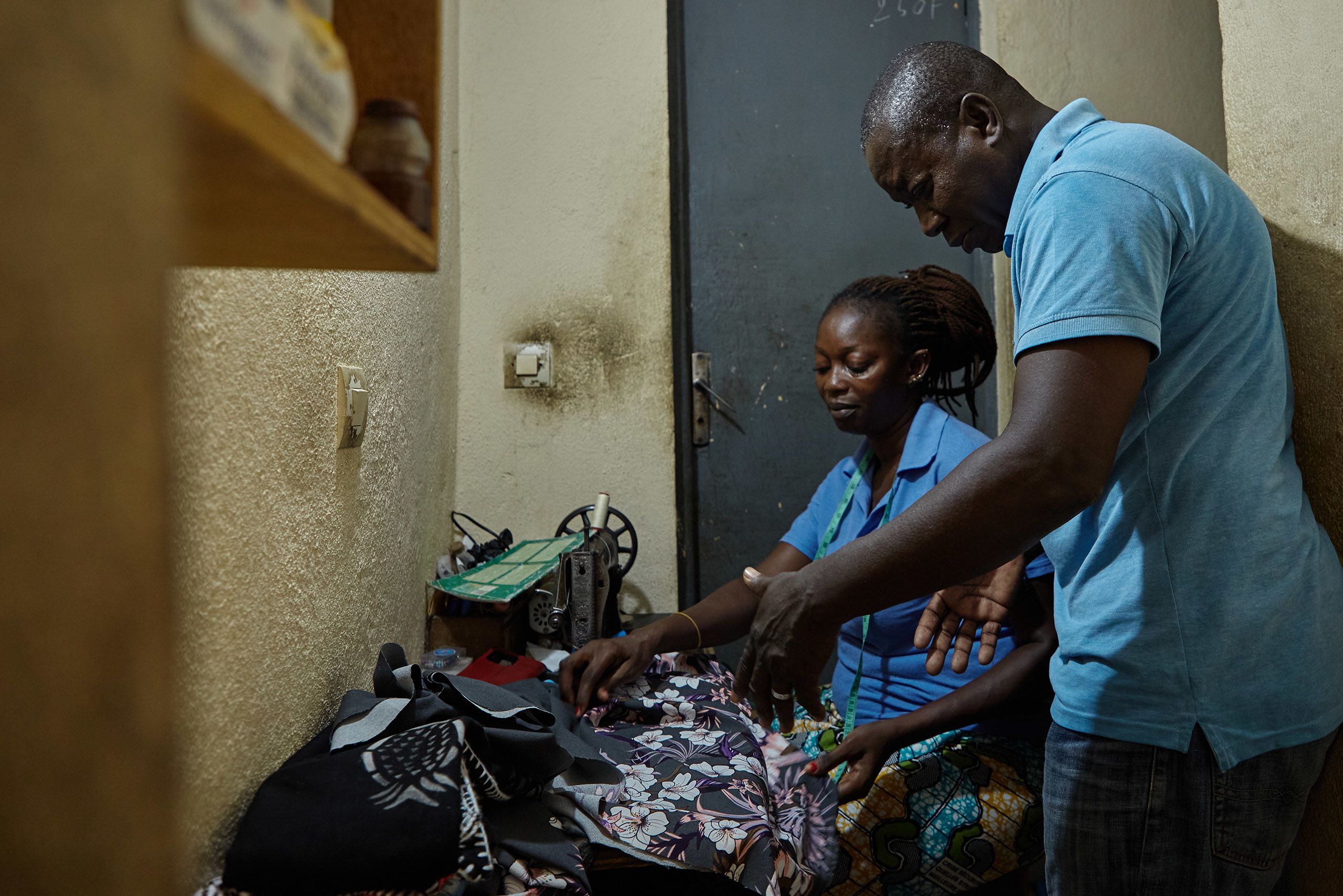
Powering Progress: Côte d’Ivoire’s Journey to Universal Electricity Access: Côte d’Ivoire’s commitment to bringing electricity to the entire nation has resulted in access to power for millions. Support from the World Bank Group, including the International Development Association (IDA) and an investment from IFC, is helping the Electricity for All initiative achieve its goals.
"We have developed the means and resources to achieve universal access by 2030."
"The energy hub of West Africa"
Powering up Côte d’Ivoire has long been a priority for its leaders. “We want to be the energy hub of West Africa,” says Ahmadou Bakayoko, Managing Director of the Ivorian Electricity Company (CIE), which operates the public electricity service. Years of investment have yielded results: the country has become one of the leading electricity exporters in West Africa. And although Côte d’Ivoire's rate of access far exceeds the Sub-Saharan Africa average of 50 percent, Bakayoko says he won’t be satisfied until access is enabled throughout the country.
Ahmadou Bakayoko, Managing Director, Ivorian Electricity Company (CIE)
Ahmadou Bakayoko, Managing Director, Ivorian Electricity Company (CIE)
There are some clear economic advantages to widespread electrification. Throughout Africa, expansion of the energy infrastructure facilitates economic growth, generates jobs, increases productivity, and reduces the cost of doing business, research shows.
In addition to those benefits, Bakayoko notes the critical ways electricity boosts people’s health and well-being: it keeps food and medicines at the optimal temperature, powers hospitals and health care facilities, enhances security, aids students’ work, and streamlines many of the housekeeping and cooking activities traditionally done by women.
“The human impact [of having electricity] is exceptional,” Bakayoko says. “Providing access to electricity represents the liberation of populations and the path to modernity.” He remembers hearing about a woman in a remote village who faced the prospect of marrying a neighbor just because his house had electricity. While considering the proposition, the Electricity for All program came to her village and showed her how the cost barrier could be overcome. She soon received her own hookup—and remained single by choice.
For Alpha Barry, who owns several residential buildings in the village of Anono, access to electricity is simply good for business. Before individual meters were installed in late 2024, his buildings received electricity from the village’s shared meters. However, “I encountered many problems with tenants, such as unpaid electricity bills and meters that overheated because of too many users,” he says. “This is no longer the case today because each tenant has a meter [and] manages their consumption.” This means that if one of those tenants doesn’t pay their invoice, his business is no longer responsible for the charge just because he is the landlord.
Real estate investor and landlord Alpha Berry (right) inspects newly-installed electrical meters at a residential building.
Real estate investor and landlord Alpha Berry (right) inspects newly-installed electrical meters at a residential building.
Before a meter was installed last year at the bistro Julien Guibre manages, he also depended on public meter that served scores of other people. It was the only way to play music and keep food and drinks cold, but it was unreliable because of the high demand. Having his own meter has transformed the bistro because “People want to eat, drink, and dance,” he says. “Without electricity, I cannot work.” Guibre’s two brothers, also entrepreneurs, established businesses next to the bistro after electricity access became affordable.
Julien Guibre takes orders from customers at his neighborhood bistro.
Julien Guibre takes orders from customers at his neighborhood bistro.
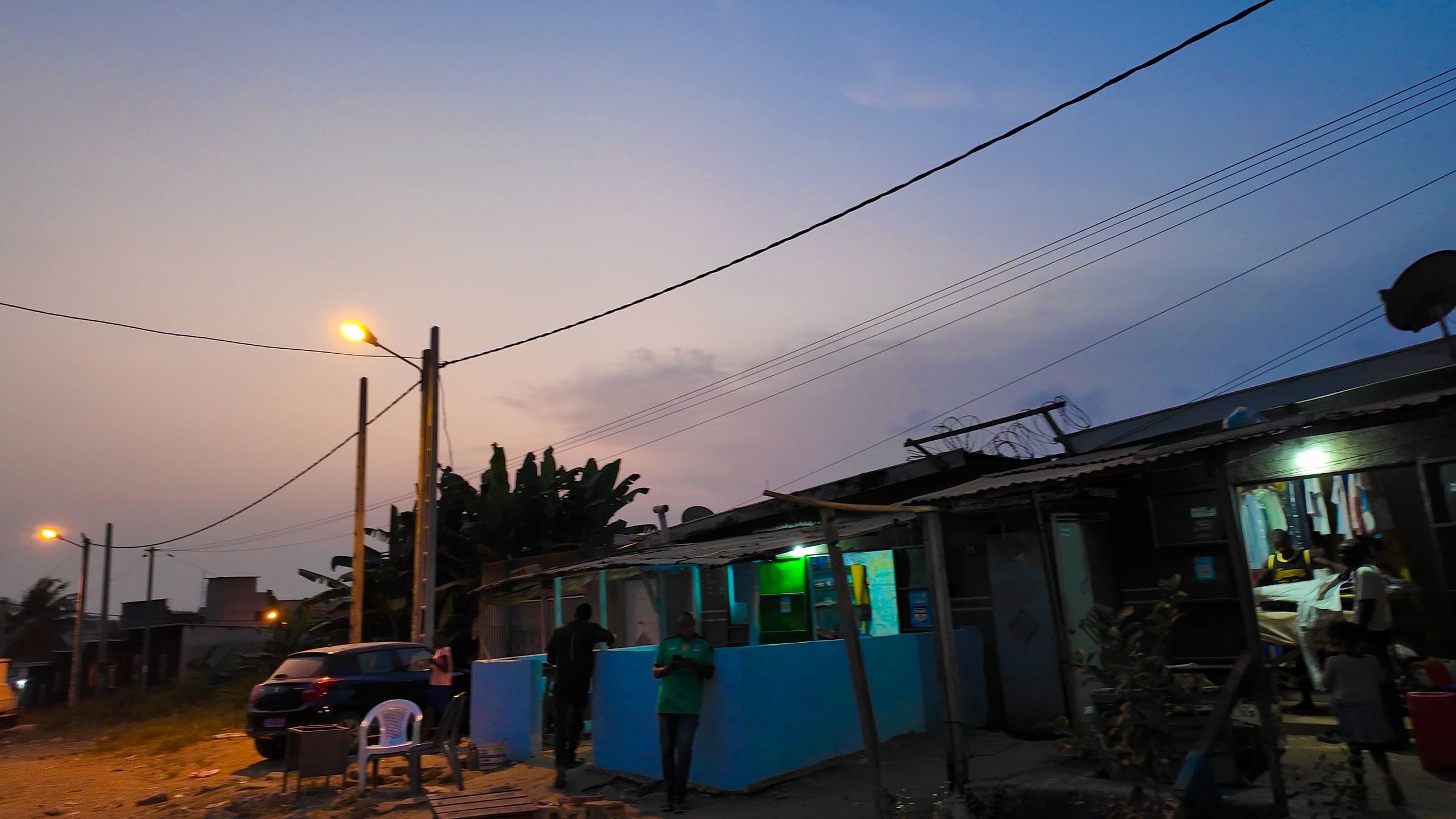
Creative solutions to difficult challenges
The Electricity for All plan didn’t originally include businesses such as those of the three Guibre brothers. The story of the program’s decade-long evolution is one of learning by doing—and responding quickly to customers’ feedback.
Early on, for example, operators had a mandate to connect homes to the network. But “in the very first village we went to launch the program, there was a problem,” says Léandre N’dri, CIE’s central director of general studies and strategic planning. Electricity for All didn’t cover connections for schools, houses of worship, or community centers, and people argued that the program should include the local infrastructure.
Léandre N’dri, Central director of general studies and strategic planning, CIE
Léandre N’dri, Central director of general studies and strategic planning, CIE
“The program was not intended for this…[but] we had to think about making it truly inclusive, ensuring that everyone’s needs are met,” N’dri recalls. “So we added these components. Then people voiced their other needs, such as electricity that would allow them to open a boutique, a hairdressing salon, a food shop or dress shop.” Integrating these requests for income-generating activities changed the program “360 degrees,” he says.
The Electricity for All program now offers businesses, schools, community centers, and houses of worship the same turn-key solution it provides homes: a connection to a prepaid meter and internal wiring, LED lights and sockets, and certification for compliance with safety standards. The program funds the balance of the cost through flexible financing to the customer, which can be repaid over a period of two to 10 years. Customers’ pay-as-you-go plan includes an additional charge per kilowatt hour as electricity is purchased via the prepaid meters.
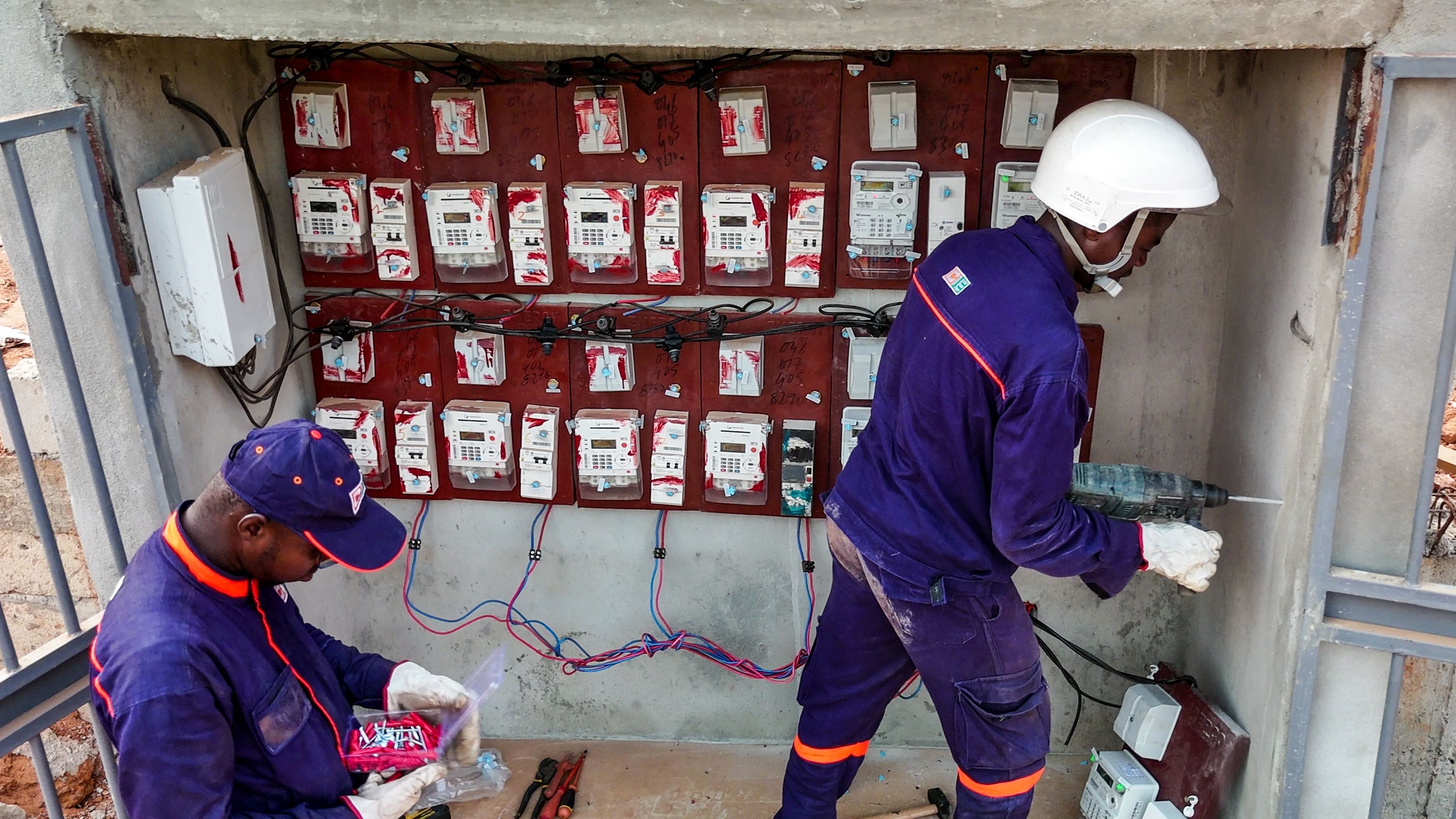
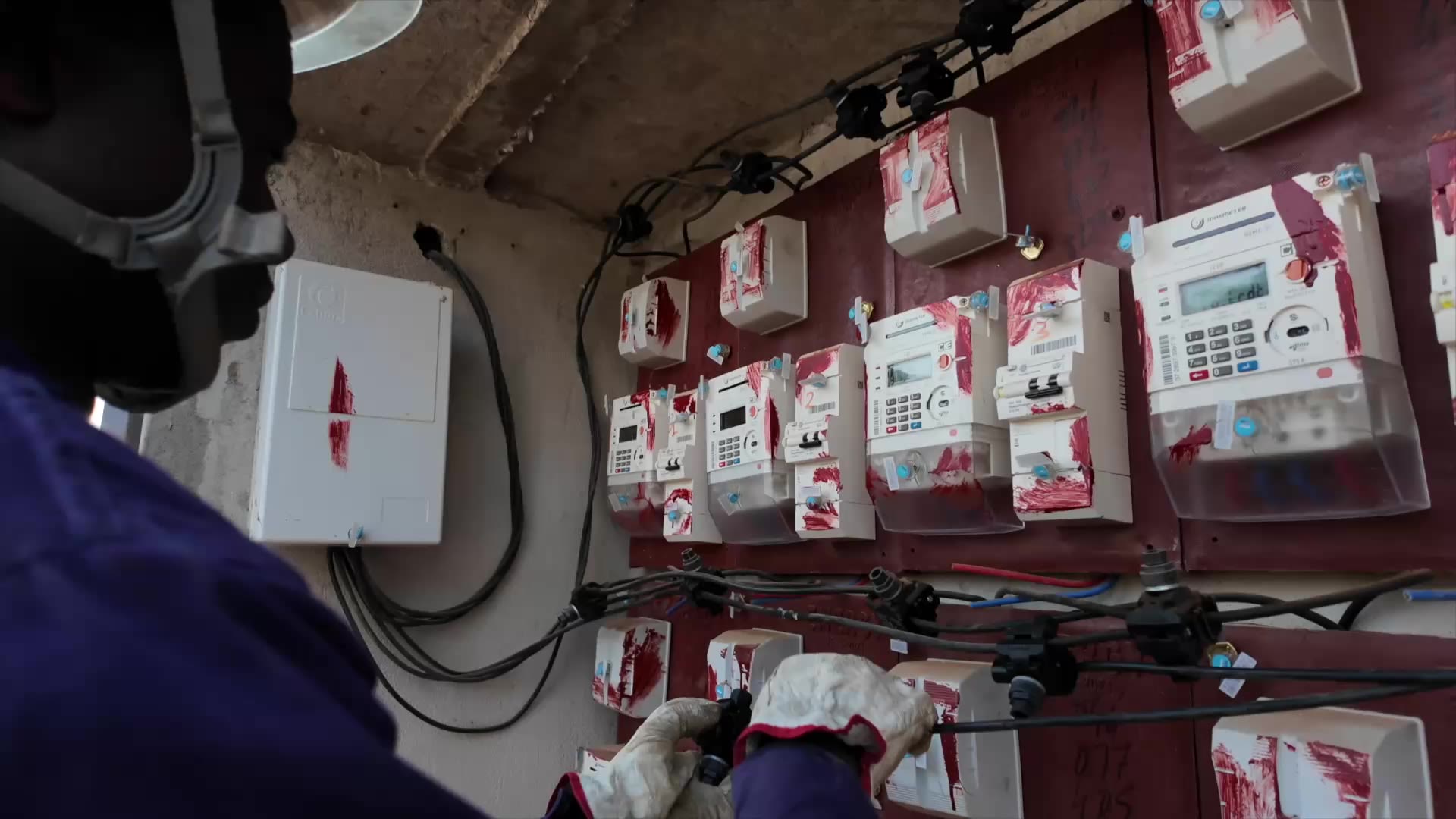
Greater access to electricity has resulted in a reduction in theft for Côte d’Ivoire’s national utility. According to CIE, implementation of the program was a contributing factor to an improvement in efficiency: distribution efficiency grew from 82.43 percent at the program’s launch to 89.12 percent at the end of 2021.
The commitment to nationwide access to electricity by 2030 created a problem-solving mind-set, says Kalifa Ehouman Narcisse, Director General of Energy at Côte d’Ivoire’s Ministry of Mines, Oil and Energy, which oversees the implementation of the Electricity for All program. It wasn't easy [because] it’s an ambitious program that doesn’t exist anywhere else, he says. “But we have developed the means and resources to achieve universal access by 2030.”
Kalifa Ehouman Narcisse, Director General of Energy, Côte d’Ivoire Ministry of Mines, Oil and Energy
Kalifa Ehouman Narcisse, Director General of Energy, Côte d’Ivoire Ministry of Mines, Oil and Energy
One of the greatest complexities arose from the need to coordinate with multiple agencies. There were several “links in the chain” necessary to deliver electrical hookups to last-mile customers, says N’dri. Electricity for All officials worked with other large-scale government initiatives that are expanding and digitalizing the power grid, such as the National Rural Electrification Program (PRONER) and the National Program for Grid Expansion (PRONEX). Coordination also required input from regulators, electricians, and transportation specialists who in some cases had to construct roads to the areas being serviced by the program.
“Hooking up is simple, but it's still a complex activity,” N’dri says. “An entire logistics chain must function for all of this to happen. Electricity for All is not an isolated project. It is part of an ecosystem.”
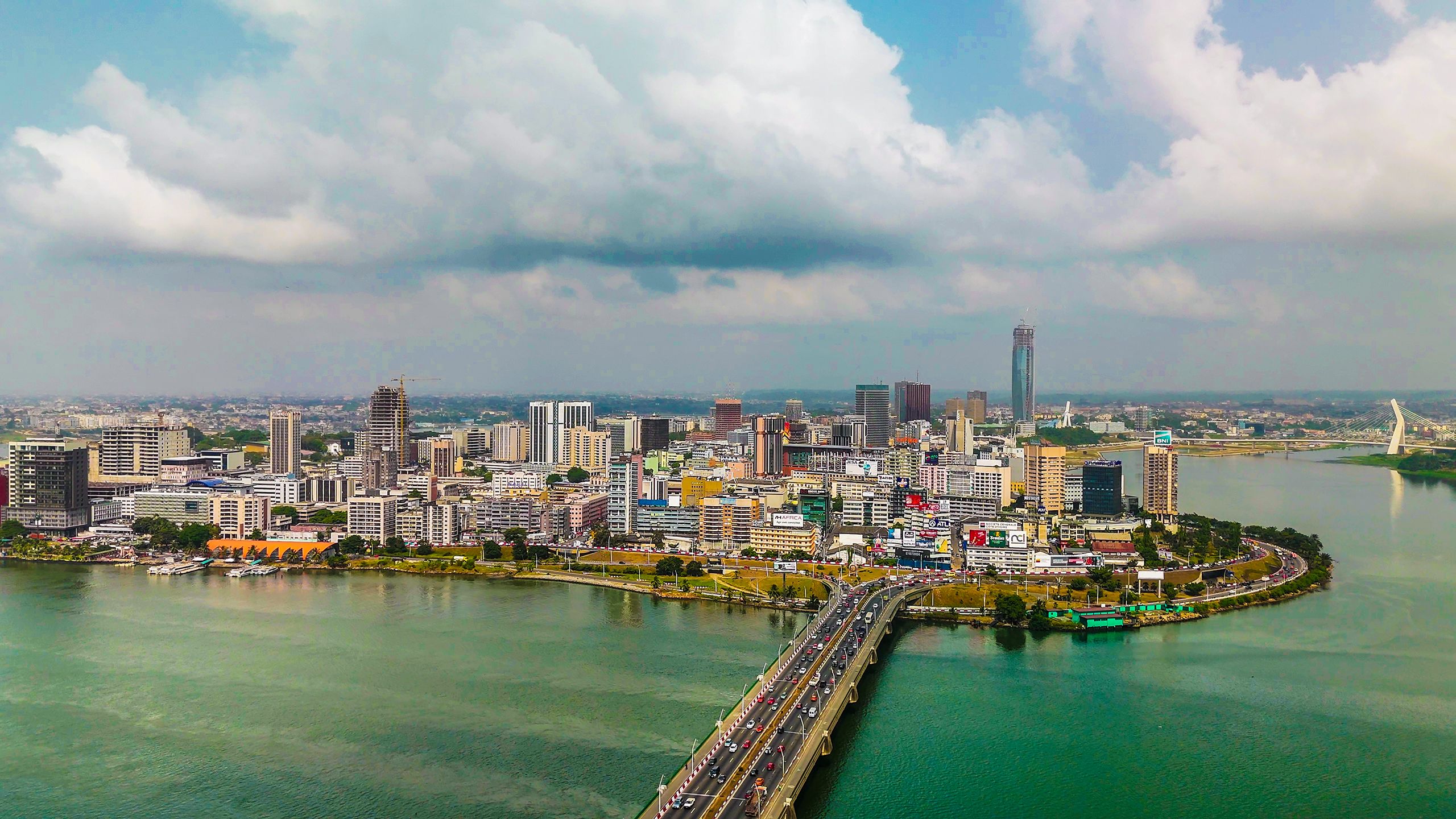
Innovative financing structure
The Electricity for All program has been supported by the IDA’s $300 million National Electricity Digitization and Access (NEDA) program since 2022. Building on this foundation, IFC’s anchor investment, which represents half of the XOF 60 billion bond, helps mobilize other potential investors to the transaction, says Marina Diagou, IFC Investment Officer.
By reinforcing the credibility of the issue in the market and encouraging other investors, such as national pension funds, it “sets a new standard in the region” as the first social bond issued in the energy sector in the eight-nation West African Economic and Monetary Union (WAEMU), she says. (Social bonds are financial tools aimed at advancing social development goals.) The World Bank Group’s Joint Capital Markets Program (J-CAP) played a critical role by recommending regulatory guidelines that served as a blueprint for the PEPT transaction and other social bonds, and by reducing overall costs related to the transaction.
Financing for the program has changed since its launch in 2014. Pre-financing for the meters was first done through the direct provision of CIE funds, and financing mechanisms were gradually diversified, Bakayoko explains. Through CIE, the government mobilized donors in addition to the financing originally in place. Donors include the African Development Bank, the International Development Association, Groupe Agence Française de Développement (AFD Group), the International Development Association, KfW Development Bank, and the World Bank.
Now, with IFC’s bond, the private sector is playing an important role, Bakayoko says. The innovative financing structure involved the creation of a special-purpose vehicle (SPV) to raise funding against the flow of payments from households that are repaying the cost of connection to the electricity grid over time. This process is called securitization. Securitization converts highly illiquid assets into tradable securities and enables investors to directly finance a diversified portfolio of assets. It can provide long-term local currency funding for priority projects, including infrastructure expansion, that may be too large or too risky for commercial banks. The number of securitization transactions in the West African market has increased and the market is expected to grow, research shows.
IFC’s participation as lead investor in the securitization “has helped attract local private investors such as banks and individuals,” according to Zahalo Silué, Chairman of the PEPT Fund. "This securitization will be repeated, with a wider participation of the local private sector, to mobilize the necessary funds to achieve universal access to electricity," he says. "This can serve as an example for similar projects in the region."
Zahalo Silué, Chairman, PEPT Fund
Zahalo Silué, Chairman, PEPT Fund
N’dri is also optimistic about how Electricity for All can transform Africa. For Côte d’Ivoire, he believes that universal access to electricity is achievable because people want it so deeply. “Every marketer will tell you about a product that people were enthusiastic about and which created great demand,” he says. “People are passionate about wanting access to electricity. So, faced with this enthusiasm…we offer a solution that works.”
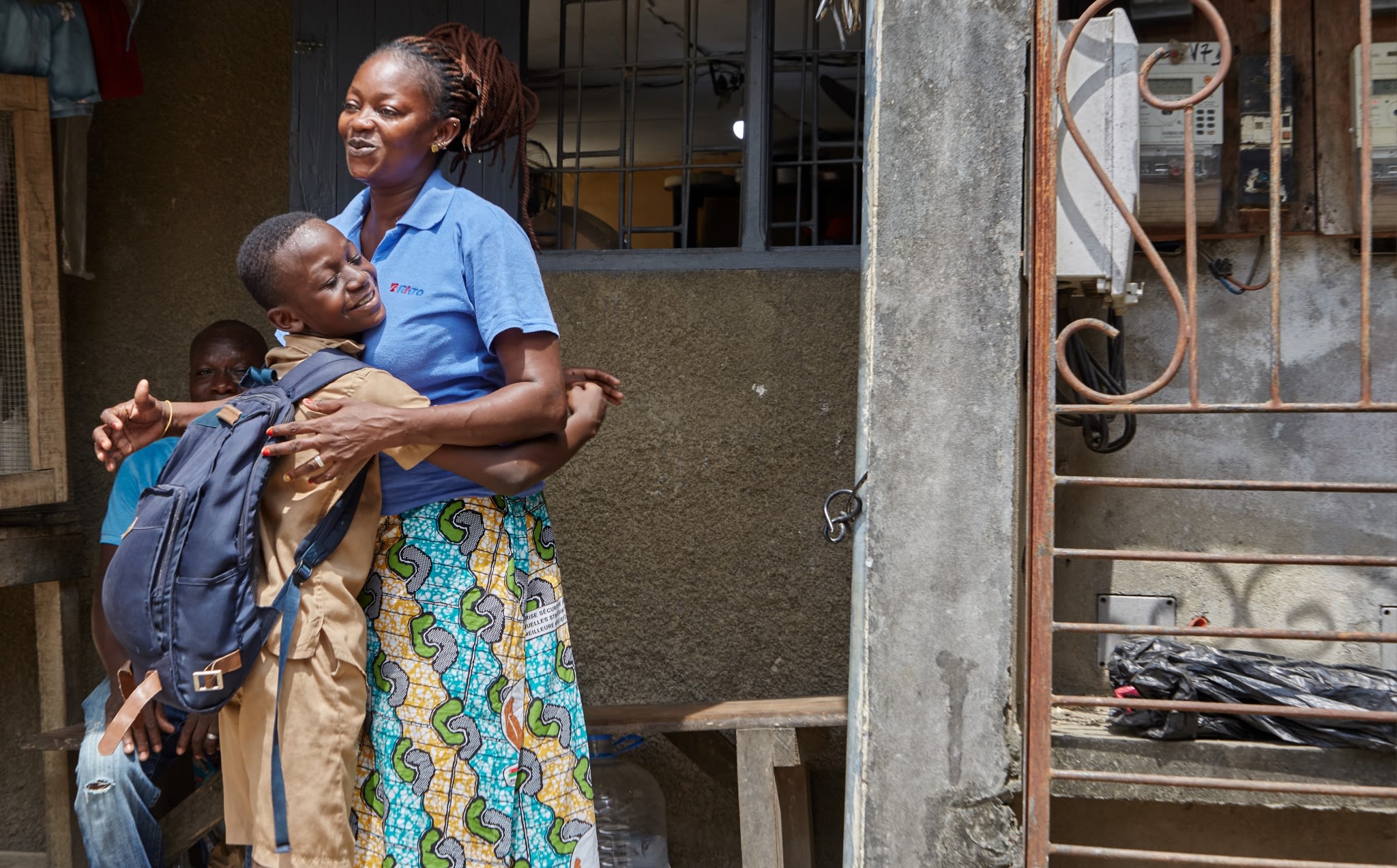
This project falls under the World Bank's Joint Capital Markets Program (J-CAP) to develop and deepen WAEMU's capital market. J-CAP's work in WAEMU is supported by the governments of Germany and Norway. J-CAP’s global capital markets development efforts are supported by the governments of Switzerland, Germany, Luxembourg, Japan, Australia, and Norway.
IFC's investment is supported by the International Development Association (IDA) 20 Private Sector Window Blended Finance Facility and Local Currency Facility, which helps provide longer-term local currency funding that is not readily available in the market.
Read more here



